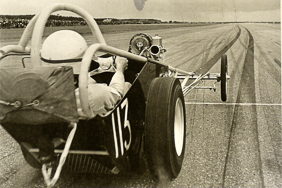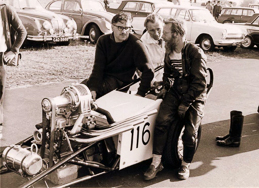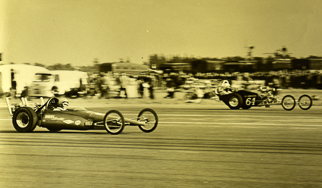
As told exclusively to
Alan Allard watched his father Sydney build the first British dragster in 1960 and saw it run at various sprints and on airport runways throughout the country in the early 60s.
In 1964 Sydney decided he wasn’t going to drive anymore handing the keys to Alan who got his first experience of driving a dragster, jumping from a rally 100 bhp Ford Anglia, to a 5.7 litre V8 supercharged machine. Alan also drove one of the new blown 1500 Ford powered Allard Dragons and was kept busy driving both dragsters at the 1964 Drag Festivals.
A second big Allard Dragster was built at the end of 1964 and Alan was once again in the driver’s seat driving in the rain at Blackbushe during the 2nd Dragfest. Then in 1966 Alan took it to Elvington for a shot at the quarter mile standing start world record.
Alan also ran the Allard Dragoon Anglia at Santa Pod in the 60s taking many Competition Altered wins.
Alan's story was written by Alan, edited by Nick Pettitt and published by Eurodragster.com editor Simon Groves with help from Andy "Tog" Rogers. All pics are from the Allard Archives unless marked otherwise.
After the failure of his twin Steyr V8 engined sprint car in 1959, my father Sydney decided to build the first dragster outside the USA. This sport, which had started in the USA in the early 1950s had two 'rails', as they were often called at that time, drag racing each other from a standing start over a 1/4 mile track. You have to remember in 1959 there were no computers or internet, so the American drag racing scene was worlds away. The only way to quickly find information was to read Hot Rod magazine, which is what Sydney did.

The twin Steyr V8 engined sprinter. |
In 1960 he employed John Hume, who came from the Cooper racing car company, to build the first Allard Dragster together with the assistance of Dave Hooper, the Allard Motor Company 'draughtsman', following Sydney's instructions.
My first memory of the Allard Chrysler Dragster was seeing it being built up on a wooden bench specially designed for it, in the small workshop below Sydney's office in Clapham High Street, Southwest London, from October 1960 to April 1961. The specification included a 5.7 litre Chrysler 'Hemi' V8 fitted with a race camshaft and larger valves, a GMC 6-71 supercharger front mounted directly driven from the crankshaft and Hilborn twin port fuel injection, max boost pressure 17.0 psi. We ran the engine on straight methanol, no nitro, so the engine was in a relatively mild state of tune. We never dyno tested the engine but estimated the power to be around 700-750 bhp at 6,000 rpm.

Dave Hooper on the left John Hume right while Sydney operates the controls. |
In Hot Rod magazine, Dean Moons hot rod shop had an advert showing Dean's Mooneyes dragster with the 5.7 Chrysler engine and front mounted blower. So, Sydney contacted Dean in California and said he wanted to use this engine build in his new dragster. In due course we were sent the wonderful Moon catalogue displaying hot rod and drag racing equipment and we purchased all the parts from Moon.
We soon realised that the RAC competition rules did not have a classification for dragsters, so it would have to be classed as a single seat race car, with brakes required on all four wheels and a body covering the engine. This meant a radical redesign with a much stronger chassis and front wheel brakes.

Ready for testing. |
John Hume completed the dragster over winter and had it ready for testing early in 1961. I went with my father on the test days at North Weald and Debden airfields. We also tested the triple braking parachute, no one in Europe had any experience of driving a dragster in 1961.
The first time the new dragster appeared in front of the press was in June 1961, on the club straight at the Silverstone racetrack. My father, who was doing all the driving at this time, put on a good show with some noisy and exciting runs, reaching around 160 mph in the quarter mile.

Sydney climbs aboard at Silverstone. |

Ready for blast off. |

Some runs were done from a rolling start. |

Looks like the mayor and mayoress were there checking out the timing setup. |

The mayor tries out the hot seat. |
In 1961 there were no proper drag strips. Santa Pod did not exist, so there were only one or two venues available. Sydney ran at Riccall in Yorkshire and at Wellesbourne airfield. In 1962 the dragster ran at Debden airfield in the National Speed Trials and Sydney became Autosport sprint champion. Journalist John Blunsden featured a big article on the Allard Dragster in the March 1962 Hot Rod magazine.
Accelerating from zero to around 170 mph in ten seconds in a machine with no rear suspension, crude steering, massively heavy clutch and ineffective brakes, on an old airfield runway scattered with landing lights and with a surface that varied between rough and dangerous, could be described as a tad more than exhilarating. The seating position was hazardous, as you sat just to the rear and astride of the differential, with eight exhaust pipes exiting four on each side only inches away, creating a massive blast of heat, exhaust gas and noise, so you could be burned, gassed and deafened all at the same time.

Testing the triple chutes with the new unpainted body fitted. |

Looking good with a paint job and chrome front end and exhausts. |

Paint scheme was designed by Gerry Belton. |

Another test run. |

Sydney drove in shirt and tie. |

1961 Brighton Speed Trials. |

The Brighton course wasn't exactly straight. This is 1962 and fatter M & H Racemasters on American mags were now fitted. |
In July 1963 Dante Duce, a Las Vegas speed shop owner, telephoned my father after reading about the Allard Dragster in Sports Car Graphic. Duce proposed coming over to the UK with an American Dragster to challenge Sydney to a drag race. Sydney accepted and Duce contacted his friend and parts supplier Dean Moon who remembered Sydney Allard purchasing speed equipment from him and he agreed to let Duce use the Mooneyes Dragster and they organised a visit to the UK.
Dean Moon arrived in the UK on Sunday September 8th 1963, with his team, the Mooneyes dragster and Dante Duce the driver. The first meeting was at Silverstone on Tuesday 10th September, where the American team were resplendent in their white trousers and jackets, embellished with large yellow and black moon eyes and topped off with white Stetsons. This was in stark contrast to the Brits with their formal shirts and ties and hardly a t-shirt in sight.
Silverstone was the first venue chosen for the match drag race between Mooneyes and the Allard Dragster. After single runs by both cars Duce and Sydney came out for a side-by-side race. Duce got wildly out of shape in Mooneyes while Sydney was slower off the line with both cars crossing the finish line together. Then Mooneyes came out for another solo smoking the tyres to a 9.48 at 167mph, the quickest and fastest quarter in the UK at the time leaving two black lines for most of the quarter mile. The assembled journalists were suitably impressed.

Sydney with Dante Duce at Silverstone. |

Sydney and Duce had a duel in Anglia Allardettes, Duce just took the win. |

Mooneyes was attracting attention at Silverstone. |

George Brown on Super Nero was running ten second quarters. |

Duce left his mark after a 9.48/167mph blast. |
We went to the Brighton Speed Trials for the second meeting. At this point Mickey Thompson, an extrovert showman drag racer from California, who had got wind of the challenge match, appeared on the scene with his nitro fuelled dragster. Some hair raising, smokey, demonstration runs were made on the rough track, at the end of the meeting. The huge crowd, who had waited all day to watch the show, were not disappointed.
After a sprint meeting on a bumpy track at Church Lawford the following Saturday the final demonstration run was on Sunday 22nd September at RAF Debden Airfield in Essex which had a wide smooth surface ideal for full power runs. A large crowd had gathered, having heard about the spectacular Brighton Speed Trial event held one week previously. This time the Allard dragster sheared the supercharger drive gear, so after laying down one fast run it was unable to take any further part. However, the two American dragsters put on a show that is still remembered by those that were there.
The final run, between Dante Duce in the Mooneyes dragster and Mickey Thompson, in his Harvey Aluminum dragster, proved to be a key moment in the history of UK drag racing. Dean Moon dropped the starting flag. The earth shook from the noise and power released, while smoke from the burning rubber filled the air to such an extent that Duce could not see the track and Mickey took the win in 9.47 seconds. Earlier, on a solo run, Mickey clocked a record breaking 8.84 at 178mph.
Nothing like this had ever been seen before in the UK in 1963. This demonstration set the scene for what was to follow in future years.

Dean Moon waves the flags as Thompson and Duce engulf everything in tyre smoke. |

Duce looking cool in an Allard J2. |
From 1964 my father handed all the dragster driving to me. I was 24 in 1964, so I got my first experience of driving a dragster, jumping from a rally 100 bhp Ford Anglia, to a 5.7 litre V8 supercharged dragster.
As there were no other similar dragsters in the UK or Europe at that time, the dragster project was something of a leap in the dark. On one of my test runs on a very rough airfield test track, I hit a landing light embedded in the runway at about 150 mph, the jolt from the impact, together with the wind pressure, was enough to tear my crash helmet off. The supercharged engine running on methanol was quite tractable, so you could trundle around at 50 mph or so, in top gear and then with one prod of the throttle, the machine was fired to the horizon with neck snapping acceleration reaching 150 mph in about five seconds.
We always started in top gear, so it took some practice to get off the line with just enough rpm and not too much tyre smoke. I have a picture of my father standing on the start line encouraging me to use more revs (about 5000 rpm in practice). The next time I got the tyres spinning and smoking was at the last round of the 1964 Drag Festival at Blackbushe, when I got down to 10.28 seconds, which was the quickest time achieved with the first Allard dragster.

Alan in the Allard dragster at Blackbushe. |

With smaller slicks fitted smoky starts were now possible. |

George Wells hoists the Union Flag, Sydney stands by as Alan hits the loud pedal. |
In 1964 the Allard Motor Company had long since stopped building cars and had turned to selling motor accessories and performance conversions including Shorrock superchargers. I proposed that we build a 'mini' dragster, with a supercharged 1500 Ford engine. John Hume, who had built the big dragster, now built the Dragon dragster in 1964. We only built two complete Dragons and offered it for sale as a kit of parts for £495! However, the market was not ready for such an unusual machine and most people interested in hot rods and drag racing wanted to build their own dragster. We sold some racing components, and these were used with a Mk2 Dragon chassis for display on our racing car show stand in 1965.

The Works Allard Dragon. |

Available in kit form. |

The Allard stand at the 1964 Racing Car Show. |

The Dragon created plenty of interest. |

The Mk2 Dragon at the 1965 Racing Car Show. |

The Works Dragon was last raced in 1968 by Alan Ing then it disappeared. |
Many years later in 2013, Roger Hayes, an Allard J2 owner, found the remains of the 1965 Dragon chassis and many of the components and has now built-up Dragon number three. The Works Dragon was won in a competition in British Drag Racing magazine by Chris Pattison who ran it with his dad in 1966 then Alan Ing took over the running of it in 1967 and '68 but it's not been seen since then. The second Dragon still survives and is now owned by Alan Smith who runs it at Nostalgia meetings.
Driving the Dragon took some practice to get the best performance out of it. With the gear change between your knees. Starting in second gear you have to put your hand on the gear lever almost instantly for the change up. I established the UK 1/4 mile record with a time of 11.54 seconds, an 11.11 ET with a speed of 131 mph was the best run with the Dragon. If we could have run with slick tyres, which were not readily available then, we could have probably broken into the ten second bracket.
I went for the World Class F International standing start kilometre record at the Chelveston records day event. The record was held by Mickey Thompson (in the USA) at that time. This was somewhat ambitious, as the Dragon was geared for the 1/4 mile limiting maximum speed to 145 mph. I reached the 7500 rpm limit two thirds of the way down the course at around 145 mph and held the engine at valve bounce for the remainder of the run. I set a new record for the standing start kilometre in class F with a time of 21.08 seconds.

The Works Allard Dragon gets some attention. |
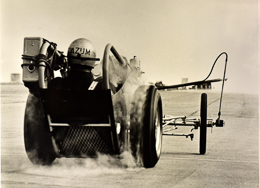
Onboard electronic recorders plotted a time and speed graph. |

Ian Smith, first owner of the second Dragon. |
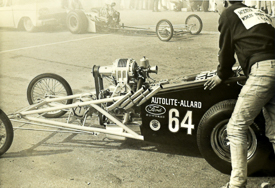
The Works Dragon went to America in 1965 and was run at the NHRA Winternationals in Pomona by the 'Modern Specialist' team. |
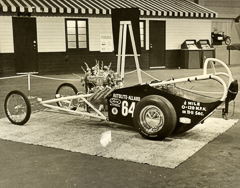
It was also entered in a car show while in America. |
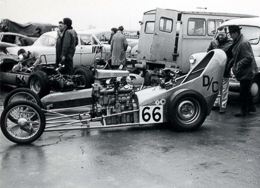
Colin Glass and Denis 'Jenks' Jenkinson used the Mk2 Dragon chassis and fitted a straight six Bristol engine in 1965 and 1966. |

With the body off you can see the detail of the Mk2 Dragon chassis. |
With the rapid development of drag racing in the UK, centered at the growing first permanent drag strip Santa Pod in 1966, it was inevitable that drag racing fans wanted to see the fastest and most powerful machines, so any development of less powerful small dragsters was eclipsed.
Gerry Belton was Allards Marketing Manager and after the Mooneyes/Thompson visit my father and Gerry started to talk about inviting an American team over the following year. It was to be a Drag Festival with a team of 10-12 American vehicles, with several events spread around the country. Gerry and his team had a big job on his hands.
The first Drag Festival meeting at the Blackbushe Airfield strip, 50 miles west of London, drew a crowd of more than 20,000 jostling to see the first runs by the nitro-dragsters of Don Garlits and Tommy Ivo, both of whom put on an awe-inspiring show, filling the track with burning rubber smoke and earth-shattering noise. The spectators were initially stunned into silence by the experience and then a wave of excited applause spread down the strip. Don Garlits ran a best of 8.09 seconds and 195 mph, to Ivo's 8.46 seconds and 184 mph.
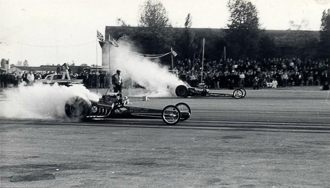
Tommy Ivo and Don Garlits 'boil the hides' at the 1964 Drag Festival. Brian Sparrow pic. |
From here the festival moved to RAF Chelveston, then Woodvale followed by Church Fenton and Kemble and the final meeting back at Blackbushe. The American drivers put on a great show, despite comparatively rough tracks and with the large crowds, most of whom got in without paying, it was still considered a success. So subsequently, a similar event was organised for 1965, but with only two venues.
A second big Allard Dragster was built by John Hume in 1964 and was ready for testing in 1965. I drove it in the 1965 Drag Festival meetings. First at Blackbushe on a damp track with puddles - this was a hair-raising experience on huge slick tyres. I was staged alongside Norman Barclay in the 'Dos Palmos' dragster. The spray from the skinny front tyres and spin from the slicks made it almost impossible to drive. We both made it to the end, but I am sure no dragsters have been allowed to run in such conditions since.

The second Allard Chrysler dragster at a wet Blackbushe. |
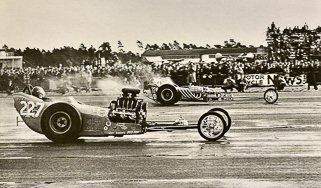
Splashing through the puddles alongside Dos Palmos. |
The 16th of October 1966 is a day I will always remember. Records day at RAF Elvington. The weather was perfect for a shot at the quarter mile standing start world record - dry and with low wind speed. With the FIA officials in position and the timing gear setup, I had to complete two runs, one in each direction within one hour. The record at that time was held by a BMW with a time of 11.34 seconds.
I made a good start, and the run was completed in 9.035 seconds, with a speed of approx 165 mph. Unfortunately, on the return run the engine developed a misfire and so the run was slowed with a time of 9.640 seconds, giving a two-way average of 9.335 seconds and an official world record. In 1966 no British car or bike had gone under 9.5 seconds for the quarter mile in the UK. Don Garlits was running low sevens in 1966 but he never set an official record.
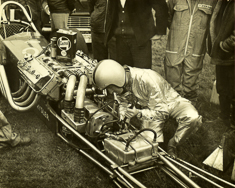
Records day at RAF Elvington. |
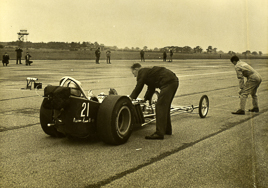
Checking the engine temperature. |

Carefully coming into stage. |
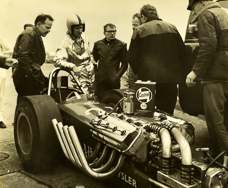
That's Les Turner to the left of Alan and Alf Hagon on the right. |

In the background Harold Bull and his BMC powered Stripduster. |
Sydney's Drag Festivals had set the scene for the sport of drag racing in the UK and Europe. There was a cruel irony in the timing of Sydney's death just as the first major drag racing events were introduced at the Santa Pod Raceway drag strip in 1966, establishing its place in British drag racing history. Without Sydney there may not have been a British drag racing scene until years later. While others went on to develop the movement, Sydney Allard can truly be described as the 'Father' of British and indeed European drag racing. It is fitting then that he has been inducted into the British Drag Racing Hall of Fame.
In 1966 I debuted the Allard Dragoon Anglia. It was a modified Ford Anglia fitted with a Shorrock blown 1500cc Ford running on methanol and I ran it in the Competition Altered Class at Santa Pod from 1966 to 1968. It came out again in 1970 with Cars and Car Conversions sponsorship.

The Dragoon Anglia at the 1966 Motor Racing Show. |

Fitted with an injected Dragon engine. |

It ran at Santa Pod in the Competition Altered Class. |
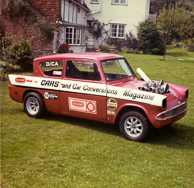
In 1970 it was sponsored by Cars and Car Conversions. |
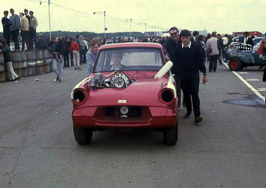
Alan gets a push through the Santa Pod pits. Ken Robbins pic. |
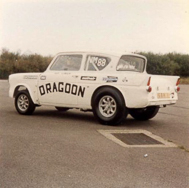
Roy Green was running it rebuilt with Pinto power in 1983. Nick Pettitt pic. |
I arranged for Clive Skilton to take over the running of the Allard Mk.2 dragster in 1968. The original Mk.1 dragster had been retired and stored by me until 1982. I met Brian Golder and arranged for him to restore it and then hand it to the Beaulieu Motor Museum when it was restored. Sadly, Brian died before he could complete the restoration, so I agreed with Brian's widow Diane, that the dragster should go to the Motor Museum. The museum gladly accepted the Dragster and put it on display. Eventually it was moved into storage, with plans to restore it when funds were available.
In 2006 Brian Taylor, whilst researching for his new book 'Crazy Horse' covering the history of UK drag racing, discovered the Allard dragster in storage at the Museum. From that point, he decided to gather a team and sponsors to restore the machine and bring it back to running condition. Work started in 2010. Up to £50,000 over a period of six years was raised and the Dragster restoration was completed in 2016 with a test run at Santa Pod.
Video Allard Dragons and Sydney interview click here
Media: click thumbnail to enlarge, click Back to return.
 |
 |
 |
 |
 |
 |
 |
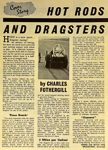 |
 |
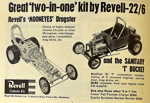 |
 |
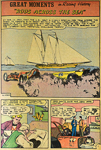 |
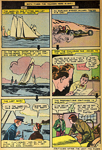 |
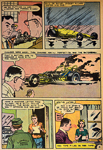 |
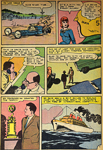 |
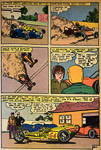 |
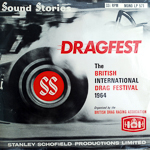 |
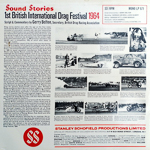 |
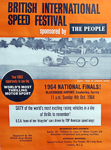 |
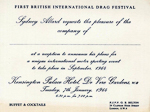 |
 |
 |
 |
 Dollar bill signed by US visitors |
 |
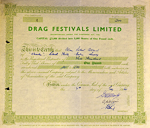 |
 |
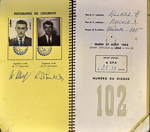 |
 |
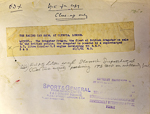 |
 |
 |
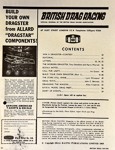 |
 |
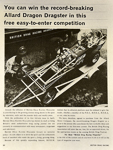 |
 |
 |
 |
 |
 |
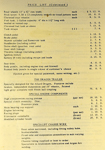 |
 |
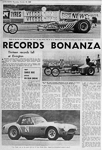 |
 |
 |
 |
 |
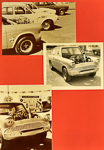 |
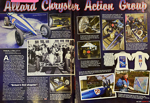 |
Photographs: click thumbnail to enlarge.
 |
 |
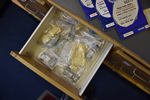 |
 |
 |
 |
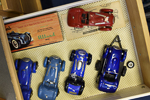 |
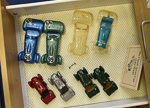 |
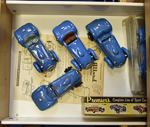 |
 |
 |
 |
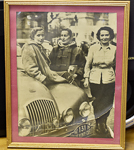 |
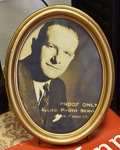 |
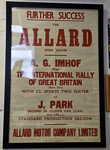 |
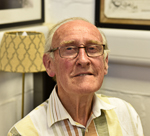 |
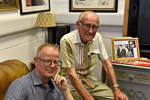 |
 |
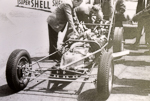 |
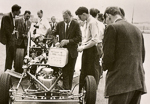 |
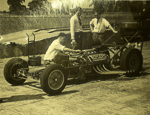 |
 |
 |
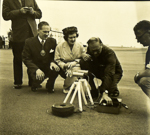 |
 |
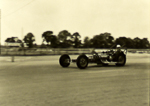 |
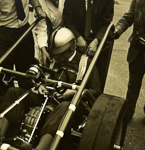 |
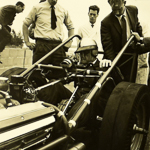 |
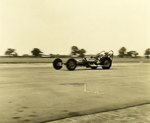 |
 |
 |
 |
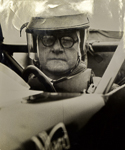 |
 |
 |
 |
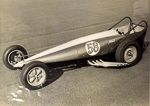 |
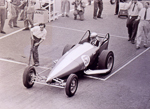 |
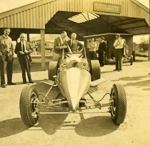 |
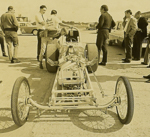 |
 |
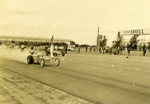 |
 |
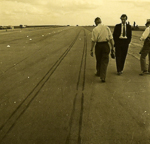 |
 |
 |
 |
 |
 |
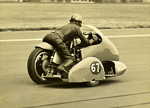 |
 |
 |
 |
 |
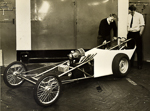 |
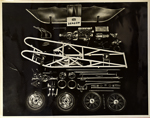 |
 |
 |
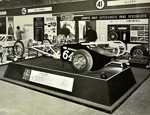 |
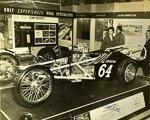 |
 |
 |
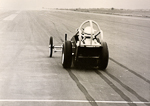 |
 |
 |
 |
 |
 |
 |
 |
 |
 |
 |
 |
 |
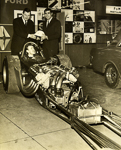 |
 |
 |
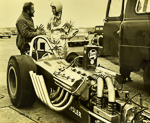 |
 |
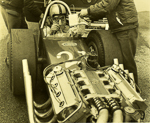 |
 |
 |
 |
 |
 |
 |
 |
 |
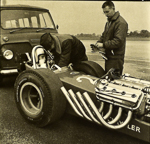 |
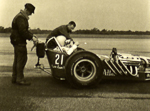 |
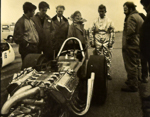 |
 |
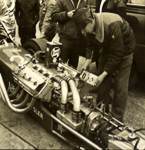 |
 |
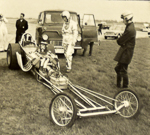 |
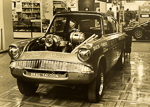 |
 |
 |
 |
 |
 |
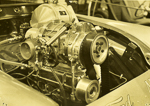 |
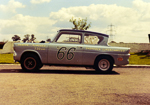 |
 |
 |
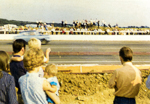 |
 |
 |
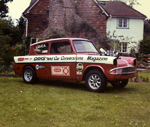 |
 |
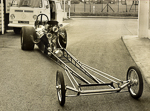 |
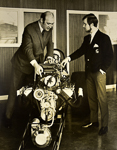 |
 |
 |
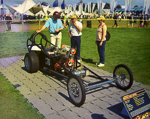 |
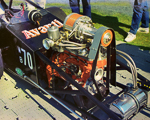 |
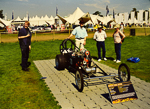 |
 |
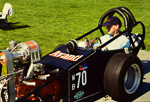 |
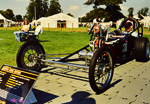 |
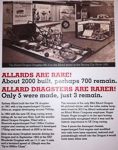 |
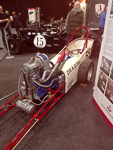 |
 |
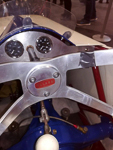 |
 |
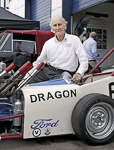 |
 |
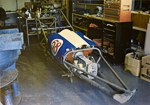 |
 |
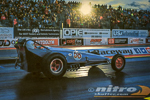 |
Feature ©Eurodragster.com
Back to pioneers index
Back to News page













